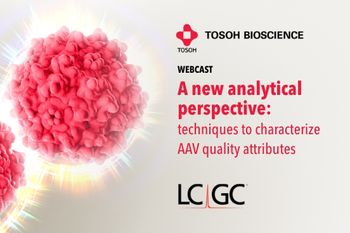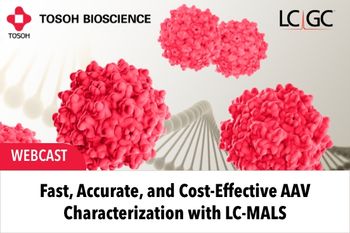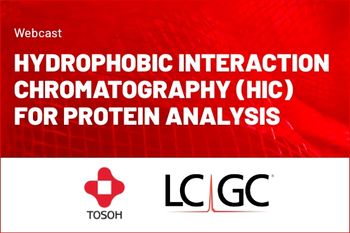
A novel HIC column featuring innovative particle technology is benchmarked for separation of high DAR species ADCs, against a reference column with conventional chemistry.

A novel HIC column featuring innovative particle technology is benchmarked for separation of high DAR species ADCs, against a reference column with conventional chemistry.

Characterizing intact biotherapeutics such as monoclonal antibodies (mAbs) and antibody-drug conjugates (ADCs) under physiological conditions is essential for understanding their critical quality attributes. This paper will examine several advanced chromatographic and detection solutions—including SEC, HIC, affinity chromatography, MALS, and HRMS—to support structural analysis, molecular weight determination, and DAR quantification.

HPLC columns are the critical component of any SEC/GPC experiments. Selecting the right column, compatible with your mobile phase, temperature range, particle size, and pore size, is essential for accurate results. Using this Column Selection Guide simplifies this process, helping you choose the ideal column for your analysis with confidence.

Polymers, generally referred to as plastics or resins, are used for a variety of purposes and have become deeply entrenched in modern life. As the petrochemical industry that produces polymers continues to grow, polymers with new structures and specialized functions continue to be developed and manufactured. Size exclusion chromatography (SEC) is a widely used technique for assessing the molecular mass of these polymers. This handbook introduces the basic principles of SEC, along with methods of analysis and examples of analysis of real samples.

GPC method development, optimization, and data interpretation can be complex and time-consuming. To support you in overcoming these challenges, we have compiled a collection of application notes covering the GPC analysis of a wide range of polymers. This application notebook provides practical insights, real-world examples, and proven methods to help you improve accuracy, streamline your workflow, and get the most from your GPC data.

Static light scattering detectors can be coupled to SEC/GPC systems for the determination of true molecular weight and size of polymers or biomolecules-independent of column calibration. This book is an essential resource for scientists and analysts using SEC or GPC, offering clear explanations of light scattering fundamentals, traditional methodologies, and the latest advancements in the field. Whether you're looking to deepen your understanding or improve your analytical accuracy, this guide offers both theory and practical insights.

A novel HIC column featuring innovative particle technology is benchmarked for separation of high DAR species ADCs, against a reference column with conventional chemistry.

By using a streamlined native hydrophobic interaction chromatography-mass spectrometry (HIC-MS) method, MS-compatible ammonium tartrate salts can enhance the separation and detection of antibody-drug conjugate (ADC) drug-to-antibody ratio (DAR) species. This advanced approach overcomes historical coupling difficulties and supports rapid, high-resolution DAR profiling and real-time monitoring for improved ADC characterization and manufacturing control.

Organic solvent, pH, salt concentration, and gradient mixing rates influence HIC separations. Optimizing these factors allows for effective separation of mAbs and ADCs.

Webinar Date/Time: Tue, May 13, 2025 11:00 AM EDT

Analytical scientists are faced with the task of finding the right column from an almost unmanageable range of products. This paper focuses on columns that enable protein analysis under native conditions through size exclusion, hydrophobic interaction, and ion exchange chromatography. It will highlight the different column characteristics—pore size, particle size, base matrices, column dimensions, ligands—and which questions will help decide which columns to use.

This application note demonstrates how THF mobile phases can be replaced to implement greener, safer, and less toxic SEC methods for polymer characterization.

Webinar Date/Time: Thu, Jan 16, 2025 10:00 AM EST

Switching the GPC/SEC solvent from THF to 2-methyl-THF provides an easy swap to provide a greener, safer, and less toxic option.

Webinar Date/Time: Tuesday, September 24th, 2024 Session 1: 9:00 AM EDT | 6:00 AM PDT | 2:00 PM BST | 3:00 PM CEST Session 2: 1:00 PM EDT | 10:00 cAM PDT | 6:00 PM BST | 7:00 PM CEST

Characterizing the ratio of tumor-killing payload to cancer-binding antibody (DAR) is a critical quality attribute that helps determine the potential potency of a given antibody-drug conjugate (ADC) candidate. The TSKgel® HIC-ADC Butyl column, developed by Tosoh Bioscience, enables improved HIC-based separations for quantifying the DAR of ADCs.

Learn how to improve the accuracy of viral particle analysis using the combination of SEC-MALS and IEX.


This innovative AEX method replaces toxic TMAC with non-toxic choline-Cl, ensuring safety and efficiency in AAV capsid analysis, applicable across multiple AAV serotypes.

The increased demand for AAV therapies can be met by using LC-MALS to efficiently assess AAV purity without the financial burden.

Webinar Date/Time: Airing 1: Wednesday, January 31, 2024 at 9am EST | 2pm GMT | 3pm CET Airing 2: Wednesday, January 31, 2024 at 1pm EST | 12pm CST | 10am PST

Webinar Date/Time: Thursday, December 7, 2023 at 9am EST | 2pm GMT | 3pm CET Thursday, December 7, 2023 at 1pm EST | 12pm CST | 10am PST

Webinar Date/Time: Thursday, September 7, 2023 at 9am EST and 2pm ES

MALS detection coupled with AEX chromatography can aid in the characterization of AAVs.

Adeno-associated viruses (AAVs) have recently gained significant attention in the field of gene and cell therapy. In this podcast, an overview of chromatography techniques for the characterization of AAVs will be discussed by Dr. Phu Duong. The discussion will highlight the most versatile and powerful detection technique to accurately characterize AAVs that is easy to adapt and implement.


Determine down to 8x10^9 AAV capsids and separate impurities of AAV samples by separation using a mixed-bed SEC column & highly sensitive MALS detection.

Webinar Date/Time: Wed, Jun 28, 2023 9:00 AM EDT

Polymers are gaining more attention in many new fields such as pharmaceutical applications. However, optimizing the final properties of the polymers associated with these new application areas is challenging for chemists and analysts. Polymer architecture plays a crucial role to optimize the end use or process-related properties. Size exclusion chromatography in combination with advanced detectors such as light scattering, viscometer, and refractive index is a powerful tool for the comprehensive characterization of macromolecules with various architectures. In this podcast, Dr. Subin Damodaran will explain how to understand the structural properties of a polymer by providing their molecular sizes such as radius of gyration (Rg ) and hydrodynamic radius (Rh), and intrinsic viscosity.

Polymers are gaining more attention in many new fields such as pharmaceutical applications. However, optimizing the final properties of the polymers associated with these new application areas is challenging for chemists and analysts. Polymer architecture plays a crucial role to optimize the end use or process-related properties. Size exclusion chromatography in combination with advanced detectors such as light scattering, viscometer, and refractive index is a powerful tool for the comprehensive characterization of macromolecules with various architectures. In this podcast, Dr. Subin Damodaran will explain how to understand the structural properties of a polymer by providing their molecular sizes such as radius of gyration (Rg ) and hydrodynamic radius (Rh), and intrinsic viscosity.

Published: October 4th 2021 | Updated:

Published: September 29th 2021 | Updated:

Published: May 21st 2021 | Updated:

Published: June 1st 2022 | Updated: